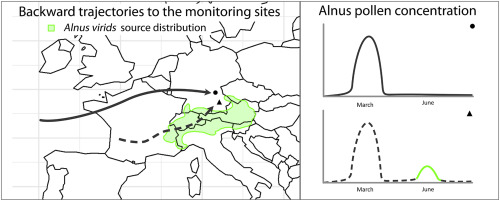当前位置:
X-MOL 学术
›
Atmos. Environ.
›
论文详情
Our official English website, www.x-mol.net, welcomes your
feedback! (Note: you will need to create a separate account there.)
High post-season Alnus pollen loads successfully identified as long-range transport of an alpine species
Atmospheric Environment ( IF 4.2 ) Pub Date : 2020-06-01 , DOI: 10.1016/j.atmosenv.2020.117453 Homa Ghasemifard , Wael Ghada , Nicole Estrella , Marvin Lüpke , Jose Oteros , Claudia Traidl-Hoffmann , Athanasios Damialis , Jeroen Buters , Annette Menzel
Atmospheric Environment ( IF 4.2 ) Pub Date : 2020-06-01 , DOI: 10.1016/j.atmosenv.2020.117453 Homa Ghasemifard , Wael Ghada , Nicole Estrella , Marvin Lüpke , Jose Oteros , Claudia Traidl-Hoffmann , Athanasios Damialis , Jeroen Buters , Annette Menzel

|
Abstract Alnus pollen is one of the Northern Hemisphere's major aeroallergens. In Central Europe, the genus is represented by three species (Alnus glutinosa, Alnus incana, and Alnus viridis). The most common one, A. glutinosa (L.) Gaertn., is widespread in lowland riparian forests, swamps, and forest edges. However, to date is still unknown if all of them - in terms of pollen exposure - are clinically relevant for sensitized individuals. To investigate the associated pollen exposure, particularly also because of long-range transport of airborne pollen, we used backward air mass trajectories and tested this method for the year 2015, based on daily Alnus pollen concentrations at 26 sites in Bavaria, Germany. A. glutinosa's main pollen season extends from February to March, but a six-day, post-season episode was additionally identified in June. For this episode and all sites, 72-h backward trajectories were calculated at 3-h intervals using high spatial and temporal resolution ERA5 reanalysis data and the HYSPLIT (hybrid single-particle Lagrangian integrated trajectory) model. This backward trajectory method identified air masses from the alpine region in Switzerland and Austria, where relevant areas of A. viridis (Chaix) DC as potential pollen sources exist. These may explain the post-season episode in June, as additionally confirmed by its unique spatial distribution, by a considerably later flowering period, and by repeated long-range transport events as observed in a 23-year pollen time series.
中文翻译:

高季后桤木花粉负荷成功确定为高山物种的远距离运输
摘要 桤木花粉是北半球主要的空气过敏原之一。在中欧,该属由三个种(Alnus glutinosa、Alnus incana 和 Alnus viridis)代表。最常见的一种是 A. glutinosa (L.) Gaertn.,广泛分布于低地河岸森林、沼泽和森林边缘。然而,迄今为止仍不清楚是否所有这些 - 就花粉暴露而言 - 都与敏感个体具有临床相关性。为了调查相关的花粉暴露,特别是由于空气中花粉的长距离传输,我们使用了后向气团轨迹,并根据德国巴伐利亚州 26 个地点的每日桤木花粉浓度,在 2015 年测试了这种方法。A. glutinosa 的主要花粉季节从 2 月持续到 3 月,但为期六天,6 月还确定了季后剧集。对于这一事件和所有站点,使用高空间和时间分辨率 ERA5 再分析数据和 HYSPLIT(混合单粒子拉格朗日综合轨迹)模型以 3 小时为间隔计算 72 小时后向轨迹。这种反向轨迹方法确定了来自瑞士和奥地利高山地区的气团,那里存在 A. viridis (Chaix) DC 的相关区域作为潜在的花粉来源。这些可能解释了 6 月的季后事件,另外还通过其独特的空间分布、相当晚的开花期以及在 23 年花粉时间序列中观察到的重复远程运输事件来证实。使用高空间和时间分辨率 ERA5 再分析数据和 HYSPLIT(混合单粒子拉格朗日综合轨迹)模型以 3 小时为间隔计算 72 小时后向轨迹。这种反向轨迹方法确定了来自瑞士和奥地利高山地区的气团,那里存在 A. viridis (Chaix) DC 的相关区域作为潜在的花粉来源。这些可能解释了 6 月的季后事件,另外还通过其独特的空间分布、相当晚的开花期以及在 23 年花粉时间序列中观察到的重复远程运输事件来证实。使用高空间和时间分辨率 ERA5 再分析数据和 HYSPLIT(混合单粒子拉格朗日综合轨迹)模型以 3 小时为间隔计算 72 小时后向轨迹。这种反向轨迹方法确定了来自瑞士和奥地利高山地区的气团,那里存在 A. viridis (Chaix) DC 的相关区域作为潜在的花粉来源。这些可能解释了 6 月的季后事件,另外还通过其独特的空间分布、相当晚的开花期以及在 23 年花粉时间序列中观察到的重复远程运输事件来证实。存在 A. viridis (Chaix) DC 作为潜在花粉来源的相关区域。这些可能解释了 6 月的季后事件,另外还通过其独特的空间分布、相当晚的开花期以及在 23 年花粉时间序列中观察到的重复远程运输事件来证实。存在 A. viridis (Chaix) DC 作为潜在花粉来源的相关区域。这些可能解释了 6 月的季后事件,另外还通过其独特的空间分布、相当晚的开花期以及在 23 年花粉时间序列中观察到的重复远程运输事件来证实。
更新日期:2020-06-01
中文翻译:

高季后桤木花粉负荷成功确定为高山物种的远距离运输
摘要 桤木花粉是北半球主要的空气过敏原之一。在中欧,该属由三个种(Alnus glutinosa、Alnus incana 和 Alnus viridis)代表。最常见的一种是 A. glutinosa (L.) Gaertn.,广泛分布于低地河岸森林、沼泽和森林边缘。然而,迄今为止仍不清楚是否所有这些 - 就花粉暴露而言 - 都与敏感个体具有临床相关性。为了调查相关的花粉暴露,特别是由于空气中花粉的长距离传输,我们使用了后向气团轨迹,并根据德国巴伐利亚州 26 个地点的每日桤木花粉浓度,在 2015 年测试了这种方法。A. glutinosa 的主要花粉季节从 2 月持续到 3 月,但为期六天,6 月还确定了季后剧集。对于这一事件和所有站点,使用高空间和时间分辨率 ERA5 再分析数据和 HYSPLIT(混合单粒子拉格朗日综合轨迹)模型以 3 小时为间隔计算 72 小时后向轨迹。这种反向轨迹方法确定了来自瑞士和奥地利高山地区的气团,那里存在 A. viridis (Chaix) DC 的相关区域作为潜在的花粉来源。这些可能解释了 6 月的季后事件,另外还通过其独特的空间分布、相当晚的开花期以及在 23 年花粉时间序列中观察到的重复远程运输事件来证实。使用高空间和时间分辨率 ERA5 再分析数据和 HYSPLIT(混合单粒子拉格朗日综合轨迹)模型以 3 小时为间隔计算 72 小时后向轨迹。这种反向轨迹方法确定了来自瑞士和奥地利高山地区的气团,那里存在 A. viridis (Chaix) DC 的相关区域作为潜在的花粉来源。这些可能解释了 6 月的季后事件,另外还通过其独特的空间分布、相当晚的开花期以及在 23 年花粉时间序列中观察到的重复远程运输事件来证实。使用高空间和时间分辨率 ERA5 再分析数据和 HYSPLIT(混合单粒子拉格朗日综合轨迹)模型以 3 小时为间隔计算 72 小时后向轨迹。这种反向轨迹方法确定了来自瑞士和奥地利高山地区的气团,那里存在 A. viridis (Chaix) DC 的相关区域作为潜在的花粉来源。这些可能解释了 6 月的季后事件,另外还通过其独特的空间分布、相当晚的开花期以及在 23 年花粉时间序列中观察到的重复远程运输事件来证实。存在 A. viridis (Chaix) DC 作为潜在花粉来源的相关区域。这些可能解释了 6 月的季后事件,另外还通过其独特的空间分布、相当晚的开花期以及在 23 年花粉时间序列中观察到的重复远程运输事件来证实。存在 A. viridis (Chaix) DC 作为潜在花粉来源的相关区域。这些可能解释了 6 月的季后事件,另外还通过其独特的空间分布、相当晚的开花期以及在 23 年花粉时间序列中观察到的重复远程运输事件来证实。











































 京公网安备 11010802027423号
京公网安备 11010802027423号